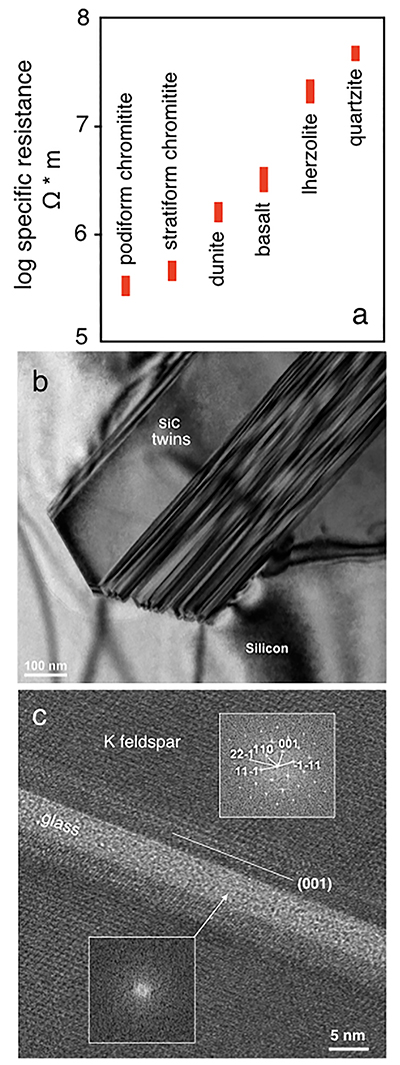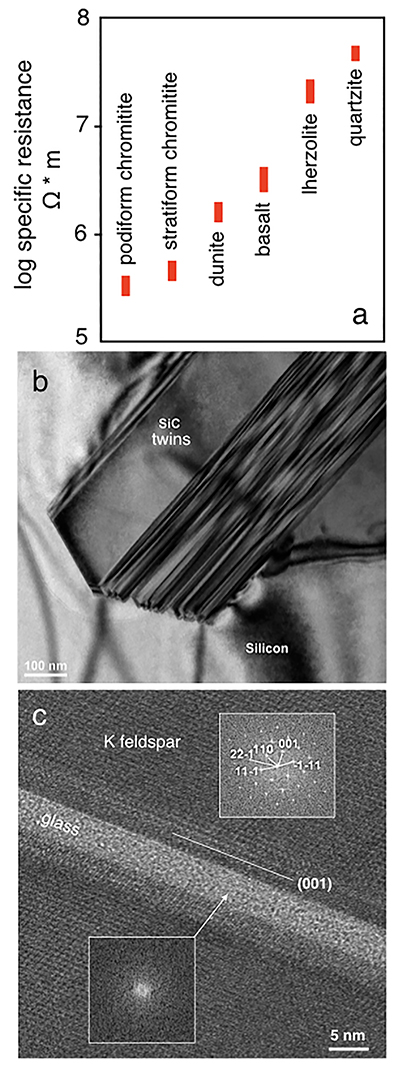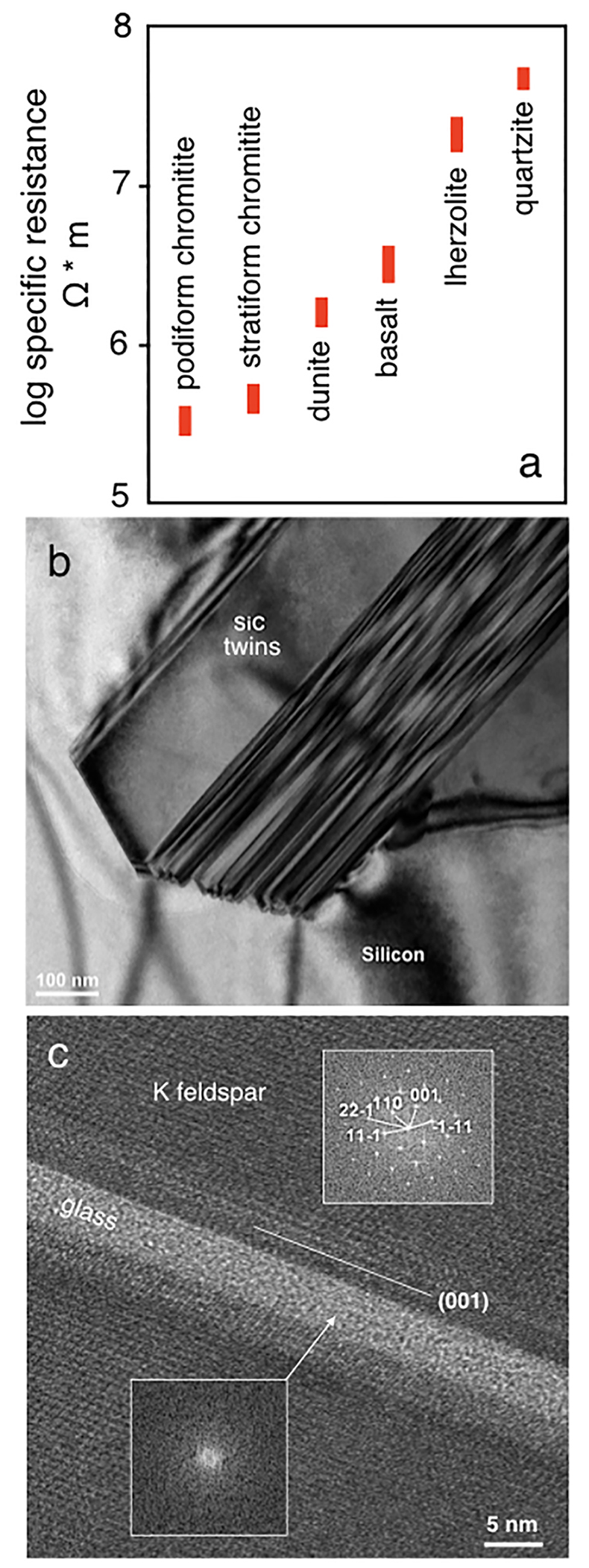Reply 2 to Comment on “Ultra-high pressure and ultra-reduced minerals in ophiolites may form by lightning strikes”
Affiliations | Corresponding Author | Cite as | Funding information- Share this article





- Article views:2,567
Cumulative count of HTML views and PDF downloads.
- Download Citation
- Rights & Permissions
Figures and Tables
 Figure 1 (a) Specific resistivities of various lithologies measured with an EG & G 5210 Lockin Amplifier (AC, 12 Hz). Rocks were cut to 8 cm3 sized cubes, then dried at 80 °C overnight to remove water films along grain boundaries. Electrodes were polyether-polyuretane fabrics impregnated with electrically conductive latex, pressed onto opposing sides of the rock cubes. Lithologies: podiform chromitite (serpentinised) from Cyprus; stratiform UG-1 chromitite from the Bushveld Complex, South Africa; FeO-rich dunite from the Mooihoek pipe, Bushveld Complex; primitive alkali basalt from the Eifel; fresh lherzolite xenolith from the Eifel; and a hydrothermally silicified sandstone from a Lower Cretaceous hot spring in Tunisia. (b) Bright-field image of a euhedral moissanite twin inside metallic Si to illustrate that experimentally generated ultra-reduced phases can be euhedral. (c) An amorphous glass lamella in K-feldspar parallel to (001), with Fast Fourier Transforms (FFTs) as insets. |
| Figure 1 |
Reply
We appreciate the comments by Yang et al. (2018) Yang, J.S., Trumbull, R.P., Robinson, P.T., Xiong, F.H., Lian, D.Y. (2018) Comment 2 on “Ultra-high pressure and ultra-reduced minerals in ophiolites may form by lightning strikes”. Geochemical Perspectives Letters 8, 6-7.to our recent proposal (Ballhaus et al., 2017 Ballhaus, C., Wirth, R., Fonseca, R.O.C., Blanchard, H., Pröll, W., Bragagni, A., Nagel, T., Schreiber, A., Dittrich, S., Thome, V., Hezel, D.C., Below, R., Cieszynski, H. (2017) Ultra-high pressure and ultra-reduced minerals in ophiolites may form by lightning strikes. Geochemical Perspectives Letters 5, 42-46.) that high pressure and ultra-reduced minerals in ophiolites may form by lightning strikes. We have carried out additional experiments to address the issues raised by Yang et al. (2018) Yang, J.S., Trumbull, R.P., Robinson, P.T., Xiong, F.H., Lian, D.Y. (2018) Comment 2 on “Ultra-high pressure and ultra-reduced minerals in ophiolites may form by lightning strikes”. Geochemical Perspectives Letters 8, 6-7.. We maintain that the ultra-reduced phases in ophiolites are best explained as plasma precipitates generated by lightning strikes.Yang et al. (2018) Yang, J.S., Trumbull, R.P., Robinson, P.T., Xiong, F.H., Lian, D.Y. (2018) Comment 2 on “Ultra-high pressure and ultra-reduced minerals in ophiolites may form by lightning strikes”. Geochemical Perspectives Letters 8, 6-7.note that ultra-reduced phases are recovered from chromitite ore sampled tens of meters below the surface. Previously, no information was provided regarding the recovery depth of phases like SiC, presumably because a near-surface origin was not considered. To semi-quantify the penetration depth of lightning bolts in crystalline rocks we measured the specific resistances of various lithologies (Fig. 1a).We note that chromitites are more conductive by ~2 orders of magnitude than silicate rocks. A rock body with a higher conductivity can provide a guide path for cloud-to-ground discharges more effectively than a lithology with lower conductivity, as cloud-to-ground discharges need a counter-pole capable of accumulating charges. The “semi-conductive” nature of the rock allows the buildup of a high electrical field which is imperative for the formation of a plasma. The penetration depth of a lightning strike is probably determined by many factors; electrical conductivity and the 3D orientation of the target rock, faulting/fracturing, presence or not of H2O along grain boundaries and fractures. We put to the discussion the possibility that conductive lithologies like chromitite exposed to frequent lightning may accumulate over time appreciable quantities of lightning strike minerals.A criticism raised is that our experimentally synthesised ultra-reduced minerals are small and anhedral, while grains in ophiolites are large and subhedral. Our ultra-reduced phases are indeed small but can nonetheless be euhedral (Fig. 1b). It is in the nature of experiments that synthetic phases are smaller than their natural analogues. Yang et al. (2018) Yang, J.S., Trumbull, R.P., Robinson, P.T., Xiong, F.H., Lian, D.Y. (2018) Comment 2 on “Ultra-high pressure and ultra-reduced minerals in ophiolites may form by lightning strikes”. Geochemical Perspectives Letters 8, 6-7.should have commented how in their opinion ultra-reduced phases like moissanite might have formed in lithologies enriched in FeO. Moissanite is only stable at ~ 6 to 8 log-bar units below the iron-wüstite buffer (IW-6 to IW-8; Golubkova et al., 2016 Golubkova, A., Schmidt, M.W., Connolly, J.A.D. (2016) Ultra-reducing conditions in average mantle peridotites and in podiform chromitites: a thermodynamic model for moissanite (SiC) formation. Contributions to Mineralogy and Petrology 171, doi: 10.1007/s00410-016-1253-9.) where most (if not all) transition elements are in a reduced metallic state. Podiform chromitites are oxidised to around FMQ which is 12 log units more oxidised than moissanite. There is no way to argue that ultra-reduced phases may have formed and have survived metastably - the diffusivities at ambient temperature in the deep mantle are too high. Oxidation would be inevitable given the FeO content of the mantle and the length of time these phases would have to survive before they reach the surface. Our preferred explanation is that the super-reduced phases precipitated out of a plasma, as did the micro-spherule ejecta found in surface sediments of the Luobusa ophiolite (for refs. see Ballhaus et al., 2017 Ballhaus, C., Wirth, R., Fonseca, R.O.C., Blanchard, H., Pröll, W., Bragagni, A., Nagel, T., Schreiber, A., Dittrich, S., Thome, V., Hezel, D.C., Below, R., Cieszynski, H. (2017) Ultra-high pressure and ultra-reduced minerals in ophiolites may form by lightning strikes. Geochemical Perspectives Letters 5, 42-46.). Plasma condensates are insensitive to the oxidation states of the lithologies within which they precipitate.We do not see how the presence of moissanite in kimberlites adds to the problem of SiC in ophiolites. Groundmass moissanite in kimberlites must be metastable because kimberlites are FeO bearing. Kimberlites form at 6 to 8 GPa and ascend so rapidly that they may bridge the distance from generation depth to the surface within hours (Wilson and Head III, 2007 Wilson, L., Head III, J.H. (2007) An integrated model of kimberlite ascent and eruption. Nature 447, 53-57.). A major driving force is CO2 exsolution. Shiryaev and Gaillard (2014) Shiryaev, A.A., Gaillard, F. (2014) Local redox buffering by carbon at low pressures and the formation of moissanite – natural SiC. European Journal of Mineralogy 26, 53-59.argued that micro-diamonds may precipitate metastably when the fluids are C-saturated. Moissanite might precipitate as well if decompression is so rapid that this phase has no time to identify FeO in the melt as a thermodynamic problem.Yang et al. (2018) Yang, J.S., Trumbull, R.P., Robinson, P.T., Xiong, F.H., Lian, D.Y. (2018) Comment 2 on “Ultra-high pressure and ultra-reduced minerals in ophiolites may form by lightning strikes". Geochemical Perspectives Letters 8, 6-7.maintain that fulgurites do not carry high pressure phases. That is not correct (cf. Carter et al., 2010 Carter, E.A., Pasek, M.A., Smith, T., Kee, T.P., Hines, P., Edwards, H.G.M (2010) Rapid Raman mapping of a fulgurite. Analytical and Bioanalytical Chemistry 397, 2647-2658.). We concede though that in fulgurites, high pressure phases are exceptional but this could be owed to the fact that most fulgurites studied occur in surface sediments that do not behave isochorically when lightning strikes. One of our experiments using a felsic granulite as target lithology indeed returned amorphous lamellae within K-feldspar (Fig. 1c). The thermal pulse apparently induced a shockwave sufficient to amorphise the K-feldspar lattice. For comparable lamellae in quartz in a fulgurite in a granite, Chen et al. (2017) Chen, J., Elmy, C., Goldsby, D.E., Gieré, R. (2017) Generation of shock lamellae and melting in rocks by lightning-induced shock waves and electrical heating. Geophysical Research Letters 44, 8757-8768.derived a minimum pressure of 7 GPa, well within coesite stability.
Acknowledgements
Chris Ballhaus thanks Andy Moore and Richard Wirth for comments on the manuscript and many insightful discussions on the possible origins of diamonds in ophiolites and elsewhere.Editor: Graham PearsontopReferences
 Show in context
Show in contextWe appreciate the comments by Yang et al. (2018) to our recent proposal (Ballhaus et al. 2017) that high pressure and ultra-reduced minerals in ophiolites may form by lightning strikes.
View in articleOur preferred explanation is that the super-reduced phases precipitated out of a plasma, as did the micro-spherule ejecta found in surface sediments of the Luobusa ophiolite (for refs. see Ballhaus et al., 2017). View in articleYang et al. (2018) ignore the genetic significance of the spherule ejecta (Ballhaus et al., 2017 and refs. therein).View in article Carter, E.A., Pasek, M.A., Smith, T., Kee, T.P., Hines, P., Edwards, H.G.M (2010) Rapid Raman mapping of a fulgurite. Analytical and Bioanalytical Chemistry 397, 2647-2658. Show in context
Show in contextThat is not correct (cf. Carter et al., 2010).
View in article Chen, J., Elmy, C., Goldsby, D.E., Gieré, R. (2017) Generation of shock lamellae and melting in rocks by lightning-induced shock waves and electrical heating. Geophysical Research Letters 44, 8757-8768. Show in context For comparable lamellae in quartz in a fulgurite in a granite, Chen et al. (2017) derived a minimum pressure of 7 GPa, well within coesite stability. View in article Golubkova, A., Schmidt, M.W., Connolly, J.A.D. (2016) Ultra-reducing conditions in average mantle peridotites and in podiform chromitites: a thermodynamic model for moissanite (SiC) formation. Contributions to Mineralogy and Petrology 171, doi: 10.1007/s00410-016-1253-9.
Show in context For comparable lamellae in quartz in a fulgurite in a granite, Chen et al. (2017) derived a minimum pressure of 7 GPa, well within coesite stability. View in article Golubkova, A., Schmidt, M.W., Connolly, J.A.D. (2016) Ultra-reducing conditions in average mantle peridotites and in podiform chromitites: a thermodynamic model for moissanite (SiC) formation. Contributions to Mineralogy and Petrology 171, doi: 10.1007/s00410-016-1253-9. Show in context
Show in contextMoissanite is only stable at ~ 6 to 8 log-bar units below the iron-wüstite buffer (IW-6 to IW-8; Golubkova et al., 2016) where most (if not all) transition elements are in a reduced metallic state.
View in article Howell, D., Griffin, W.L., Yang, S., Gain, S., Stern, R.A., Huang, J.-X., Jacob, D.E., Xu, X., Stokes, A.J., O'reilly, S.Y., Reason, N.J. (2015) Diamonds in ophiolites: Contamination or a new diamond growth environment? Earth and Planetary Science Letters 430, 284-295. Show in context
Show in contextWhy are ophiolitic diamonds characterised by 1b nitrogen aggregation states (Howell et al., 2015) when they had a long residence time within the deep mantle?
View in article Karpov, G.A., Silaev, V.I., Anikin, L.P., Rakin, V.I., Vasil'ev, E.G., Filatov, S.K., Petrovskii, V.A., Flerov, G.B. (2014) Diamonds and accessory minerals in products of the 2012–2013 Tolbachik fissure eruption. Journal of Volcanology and Seismology 8, 323-339. Show in context
Show in contextKarpov (2014) described diamonds from volcanic tuffs of the Tolbachik fissure in Kamchatka, and those diamonds are also associated with spherules, identical in shape to our experimental spherules and those reported from Luobusa.
View in article Shiryaev, A.A., Gaillard, F. (2014) Local redox buffering by carbon at low pressures and the formation of moissanite – natural SiC. European Journal of Mineralogy 26, 53-59. Show in context
Show in contextShiryaev and Gaillard (2014) argued that micro-diamonds may precipitate metastably when the fluids are C-saturated.
View in article Wilson, L., Head III, J.H. (2007) An integrated model of kimberlite ascent and eruption. Nature 447, 53-57. Show in context
Show in contextKimberlites form at 6 to 8 GPa and ascend so rapidly that they may bridge the distance from generation depth to the surface within hours (Wilson and Head III, 2007).
View in article Xu, X.Z., Yang, J.S., Robinson, P.T., Xiong, F.H., Ba, D.Z., Guo, G.L. (2015) Ultrahigh pressure, highly reduced and crustal-type minerals from podiform chromitite and mantle peridotite of the Luobusa ophiolite, Tibet. Gondwana Research 27, 686-700. Show in context
Show in contextIt seems that the diamonds were separated at the Institute of Mineral Resources, Chinese Academy of Science, an organisation that processes a wide range of ore samples for the mining industry (Xu et al., 2015).
View in article Yang, J.S., Robinson, P.T., Dilek, Y. (2014) Diamonds in ophiolites. Elements 10, 127-130. Show in context
Show in contextAre single crystal diamonds recovered from concentrates identical in terms of nano-structures to diamonds enclosed in chromite (cf. Yang et al., 2014)?
View in article Yang, J.S., Trumbull, R.P., Robinson, P.T., Xiong, F.H., Lian, D.Y. (2018) Comment 2 on “Ultra-high pressure and ultra-reduced minerals in ophiolites may form by lightning strikes”. Geochemical Perspectives Letters 8, 6-7. Show in context
Show in contextWe appreciate the comments by Yang et al. (2018) to our recent proposal (Ballhaus et al., 2017) that high pressure and ultra-reduced minerals in ophiolites may form by lightning strikes.
View in article We have carried out additional experiments to address the issues raised by Yang et al. (2018).View in articleYang et al. (2018) note that ultra-reduced phases are recovered from chromitite ore sampled tens of meters below the surface.View in article Yang et al. (2018) should have commented how in their opinion ultra-reduced phases like moissanite might have formed in lithologies enriched in FeO.View in article Yang et al. (2018) maintain that fulgurites do not carry high pressure phases.View in articleYang et al. (2018) ignore the genetic significance of the spherule ejecta (Ballhaus et al., 2017 and refs. therein).View in articleFigures and Tables







